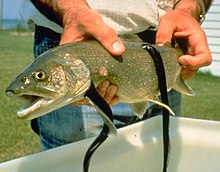Sea lamprey
| Sea lamprey | |
|---|---|
 |
|
| Sea lampreys on a lake trout | |
 |
|
| Scientific classification | |
| Kingdom: | Animalia |
| Phylum: | Chordata |
| Class: | Hyperoartia (Petromyzontida) |
| Order: | Petromyzontiformes |
| Family: | Petromyzontidae |
| Genus: |
Petromyzon Linnaeus, 1758 |
| Species: | P. marinus |
| Binomial name | |
|
Petromyzon marinus Linnaeus, 1758 |
|
| Synonyms | |
|
|
The sea lamprey (Petromyzon marinus) is a parasitic lamprey native to the Northern Hemisphere.
The sea lamprey has an eel-like body without paired fins. Its mouth is jawless, round and sucker-like, and as wide or wider than the head; sharp teeth are arranged in many consecutive circular rows. There are 7 branchial openings behind the eye. They are olive or brown-yellow on the dorsal and lateral part of the body, with some black marblings, with lighter coloration on the belly. Adults can reach a length of up to 120 cm (47 in) and a body weight up to 2.3 kg (5.1 lb).
The species is found in the northern and western Atlantic Ocean along the shores of Europe and North America, in the western Mediterranean Sea, the Black Sea, and in the shores of the Great Lakes. They have been found at depths to 4000 m and tolerate temperatures between 1.0 and 20°C. The largest European populations of sea lampreys are located throughout the south-western areas of Europe (north-central Portugal, north-north-west of Spain, and west–south-west of France). These countries also support the main fisheries of the species.
All lampreys are anadromous. From their lake or sea habitats, they migrate up rivers to spawn (followed by the death of the spawning adults); females deposit a large number of eggs in nests made by males in the substrate of streams with moderately strong current. Larvae burrow in sand and silt bottom in quiet water downstream from spawning areas and filter-feed on plankton and detritus.
After several years in freshwater habitats, the larvae undergo a metamorphosis that allows young post metamorphic lampreys to migrate to the sea or lakes and start the hematophagous feeding. Some individuals can start the hematophagous feeding in the river before migrating to the sea, where sea lampreys prey on a wide variety of fish.
The lamprey uses its suction cup-like mouth to attach itself to the skin of a fish and rasps away tissue with its sharp, probing tongue and keratinized teeth. Secretions in the lamprey's mouth prevent the victim's blood from clotting. Victims typically die from excessive blood loss or infection. After one year of hematophagous feeding, lampreys return to the river to spawn and die, a year and a half after the completion of metamorphosis.
...
Wikipedia

